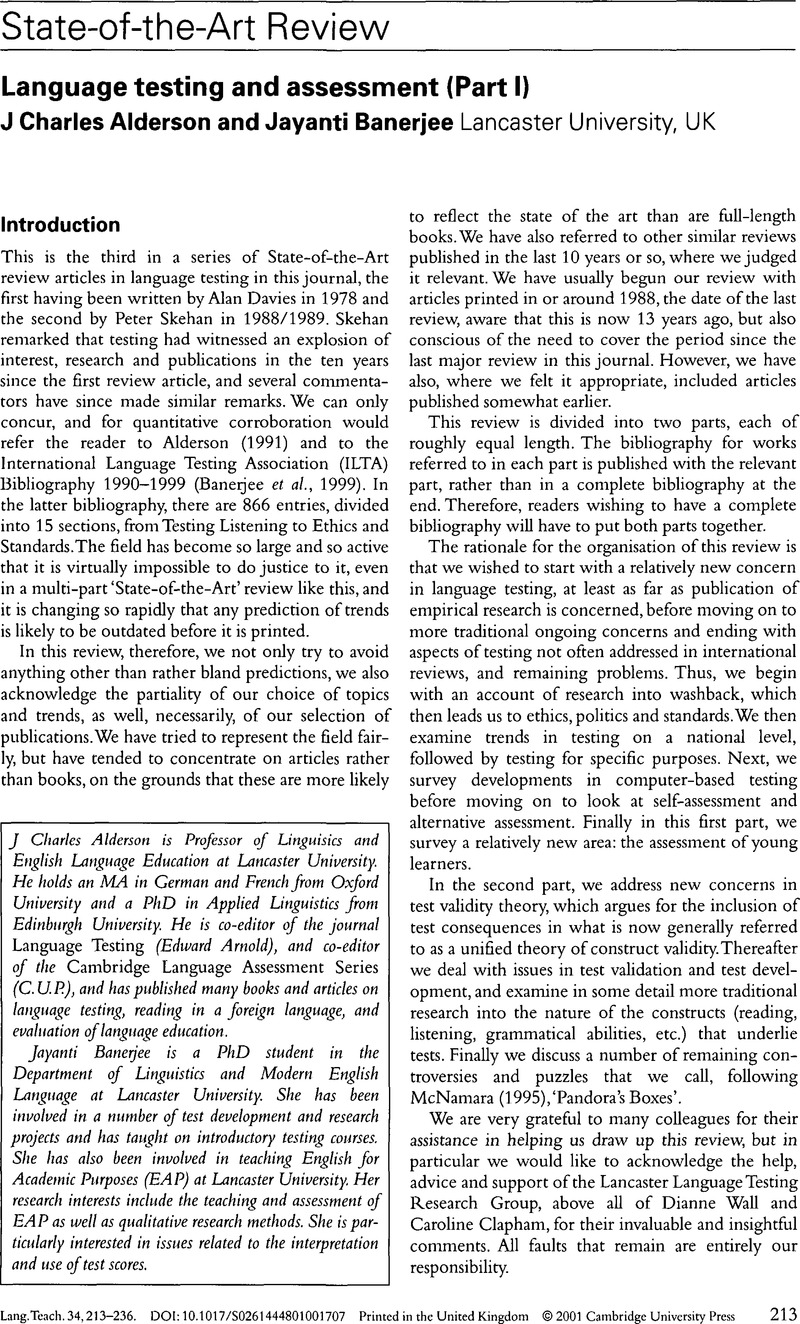Crossref Citations
This article has been cited by the following publications. This list is generated based on data provided by Crossref.
Davies, Alan
2003.
Three heresies of language testing research.
Language Testing,
Vol. 20,
Issue. 4,
p.
355.
Cumming, Alister
2004.
Broadening, Deepening, and Consolidating.
Language Assessment Quarterly,
Vol. 1,
Issue. 1,
p.
5.
Mcnamara, Tim
2004.
The Handbook of Applied Linguistics.
p.
763.
Nikolov, Marianne
2006.
Test‐taking Strategies of 12‐ and 13‐year‐old Hungarian Learners of EFL: Why Whales Have Migraines.
Language Learning,
Vol. 56,
Issue. 1,
p.
1.
Shih, Chih-Min
2007.
A New Washback Model of Students’ Learning.
The Canadian Modern Language Review,
Vol. 64,
Issue. 1,
p.
135.
Davies, Alan
2008.
Textbook trends in teaching language testing.
Language Testing,
Vol. 25,
Issue. 3,
p.
327.
Cumming, Alister
2008.
Encyclopedia of Language and Education.
p.
2146.
XI, Xiaoming
2008.
Encyclopedia of Language and Education.
p.
2316.
Abbas Mousavi, Seyyed
2009.
Multimedia as a Test Method Facet in Oral Proficiency Tests.
International Journal of Pedagogies and Learning,
Vol. 5,
Issue. 1,
p.
37.
SUZUKI, MANAMI
2009.
The Compatibility of L2 Learners' Assessment of Self‐ and Peer Revisions of Writing With Teachers' Assessment.
TESOL Quarterly,
Vol. 43,
Issue. 1,
p.
137.
Cilliers, Francois J.
Schuwirth, Lambert W.
Adendorff, Hanelie J.
Herman, Nicoline
and
van der Vleuten, Cees P.
2010.
The mechanism of impact of summative assessment on medical students’ learning.
Advances in Health Sciences Education,
Vol. 15,
Issue. 5,
p.
695.
Chik, Alice
and
Besser, Sharon
2011.
International Language Test Taking Among Young Learners: A Hong Kong Case Study.
Language Assessment Quarterly,
Vol. 8,
Issue. 1,
p.
73.
박상복
2012.
What causes washback: Perceptions and behaviour..
Journal of the Korea English Education Society,
Vol. 11,
Issue. 2,
p.
57.
Davies, Alan
2013.
The Companion to Language Assessment.
p.
1.
Chou, Mu-hsuan
2013.
A Content-Based Approach to Teaching and Testing Listening Skills to Grade 5 EFL Learners.
International Journal of Listening,
Vol. 27,
Issue. 3,
p.
172.
Chou, Mu-hsuan
2014.
Assessing English vocabulary and enhancing young English as a Foreign Language (EFL) learners’ motivation through games, songs, and stories.
Education 3-13,
Vol. 42,
Issue. 3,
p.
284.
Tochon, François Victor
2014.
Le savoir-évaluer comme politique éducative.
Mesure et évaluation en éducation,
Vol. 34,
Issue. 3,
p.
137.
Kongsuwannakul, Kunlaphak
2015.
Theoretical considerations of applications and implications of concordance-based cloze tests.
Digital Scholarship in the Humanities,
Vol. 30,
Issue. 4,
p.
541.
Alderson, J.Charles
2016.
Becoming and Being an Applied Linguist.
p.
59.
Zhao, Chuqiao
and
Gritter, Kris
2016.
Motivational effects of standardized language assessment on Chinese young learners.
Cogent Education,
Vol. 3,
Issue. 1,
p.
1227020.


